Blue Jays Explore The Historic New Orleans Collection
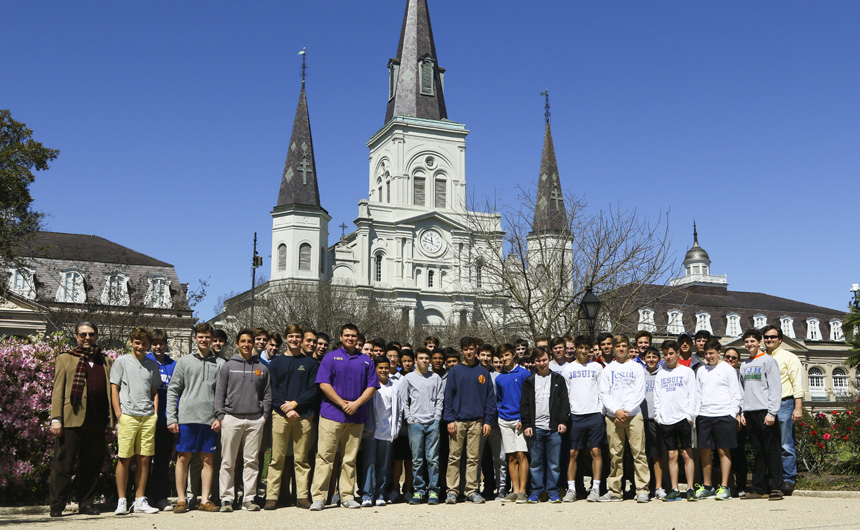
More than 50 students in Mr. Wade Trosclair’s western civilization classes seized the opportunity to visit the French Quarter and learn about New Orleans history.
For many Blue Jays, the week-long Mardi Gras holiday bridges extremes – the first half of the break is spent yelling for beads while the other abruptly shifts to the Ash Wednesday fast and decisions about which luxury to give up during Lent. This year, though, for some, it involved a home-grown history tour courtesy of their social studies teachers.
On Friday, March 3, nearly 70 Jesuit freshmen and sophomores took to the streets of the French Quarter to get a double dose of New Orleans history.
First, the group was treated to a docent-led tour of the History Galleries at The Historic New Orleans Collection. Trying to squeeze nearly 300 years of history into an hour-long tour is no easy task, but students soaked in maps and artifacts from the founding of New Orleans through the Louisiana Purchase and beyond. Docents carefully explained the forces at play in Europe during Louisiana’s early history which led to a back and forth ruling of the territory by the French and Spanish. Maps of the city in various time periods showed the influence of native populations, the emergence of slave and freed African populations, the growth of the American Sector, and the gradual expansion of the city beyond the early ramparts.
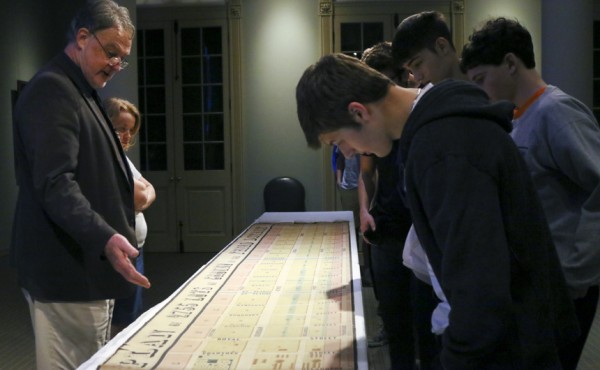
THNOC Curator Howard Margot shows students the survey of land on which the second Ursuline Convent stood in the 1840s.
Students then walked a few blocks upriver from Royal Street to THNOC gallery rooms at the Williams Research Center on Chartres Street. The curator of the Historic New Orleans Collection, Howard Margot, hosted a show-and-tell giving a glimpse at the work and artifacts of historic preservation. The gem of the presentation was a 10-foot wide street survey from the 1840s of land in the lower 9th ward which is now the Industrial Canal. Before construction began on the canal in the early 20th century, the land was the site of the second Ursuline convent in the City of New Orleans, built in 1820 and razed in 1910. Margot also projected images of the old convent digitized from glass slides in THNOC’s online catalog so students could see the splendor of the building which once existed in the spot along the Mississippi River.
Mr. Wade Trosclair ’07, who organized the group, was originally expecting only 10-20 students when the field trip was announced. “I’ve been wanting to offer this field trip to my students since June of 2013 when I was hired by Jesuit while working as a docent for The Historic New Orleans Collection,” said Trosclair. “I’m passionate about exposing the students to the rich history of Europe in a way that touches their experience as New Orleanians. This quarter in my western civilization class, we learned among other things about explorers, European empires, Napoleon, and colonization, so there was no better way to drive the point home than to see the influence of these forces on New Orleans.”
Zach Haydel, a freshman in Trosclair’s western civilization class, was happy to learn more about his hometown. “I wasn’t able to learn about New Orleans of the past since everyone doesn’t take Louisiana history as pre-freshmen. I really liked the show-and-tell, but my favorite part was looking at early maps to see what New Orleans looked like in the 18th and 19th centuries. I would definitely come back to do this again if I had the opportunity.”
Judging by the smiles on the faces of other students as they walked through Jackson Square after the tours, Haydel wasn’t the only Blue Jay happy to know a little more about the early cultural influences on the only American city who can effectively pull off the juxtaposition between the revelry of Mardi Gras and the austerity of Lent.
Galleries
The Historic New Orleans Collection Field Trip, March 3, 2017
-
 THNOC docent Cecilia Hock gives a group of students a tour of the History Galleries.
THNOC docent Cecilia Hock gives a group of students a tour of the History Galleries. -
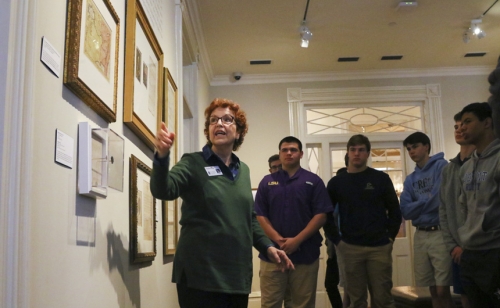 Mrs. Hock discusses the Louisiana Purchase and describes the deal made between France and Spain.
Mrs. Hock discusses the Louisiana Purchase and describes the deal made between France and Spain. -
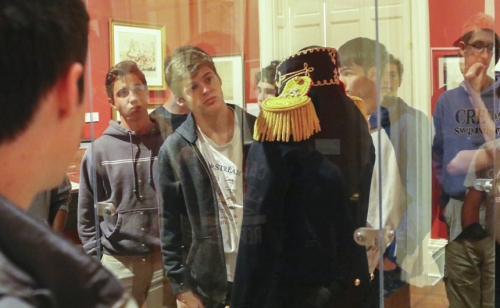 Students get a close-up look at a replica of the major general's coat worn by Andrew Jackson in 1814-15.
Students get a close-up look at a replica of the major general's coat worn by Andrew Jackson in 1814-15. -
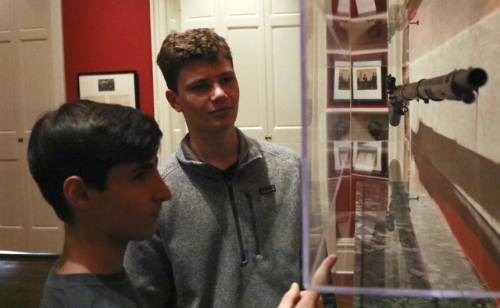 Tony Serio (left) and Ethan Varisco admire the Type III Harper's Ferry musket used by the Louisiana Militia.
Tony Serio (left) and Ethan Varisco admire the Type III Harper's Ferry musket used by the Louisiana Militia. -
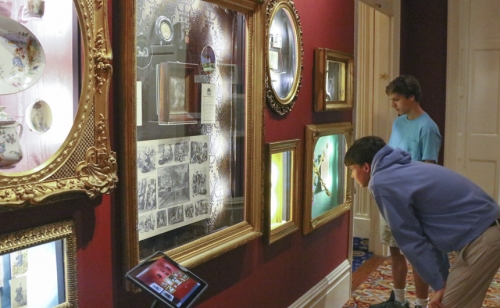 Sam Hanemann and Connor Boylan look at early Mardi Gras regalia in the 19th century rooms.
Sam Hanemann and Connor Boylan look at early Mardi Gras regalia in the 19th century rooms. -
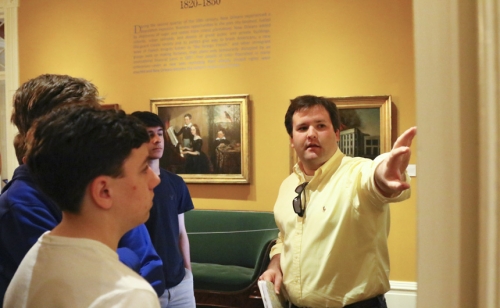 Mr. Wade Trosclair '07 points out the development of the American Sector west of the French Quarter on an early map of the city.
Mr. Wade Trosclair '07 points out the development of the American Sector west of the French Quarter on an early map of the city. -
 Students also were able to see more recent artifacts, including books by local authors and propaganda pieces from notorious local elections.
Students also were able to see more recent artifacts, including books by local authors and propaganda pieces from notorious local elections. -
 Students find a seat at the Williams Research Center to hear a presentation about New Orleans artifacts.
Students find a seat at the Williams Research Center to hear a presentation about New Orleans artifacts. -
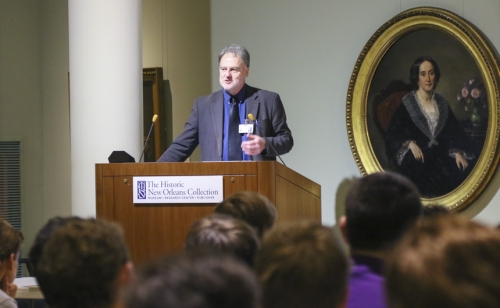 Curator Howard Margot opens with a few words about historic preservation.
Curator Howard Margot opens with a few words about historic preservation. -
 A aerial view of New Orleans was displayed with Google maps to pin point historic preservation sites in the city.
A aerial view of New Orleans was displayed with Google maps to pin point historic preservation sites in the city. -
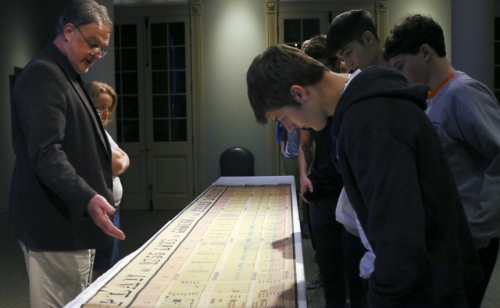 Students line up to see the 10-foot wide survey of land from the Lower 9th Ward.
Students line up to see the 10-foot wide survey of land from the Lower 9th Ward. -
 Margot explains the process of digitizing the glass negatives for historic preservation.
Margot explains the process of digitizing the glass negatives for historic preservation. -
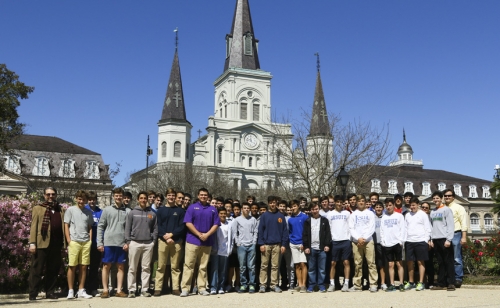 The group gets together for a final shot before St. Louis Cathedral.
The group gets together for a final shot before St. Louis Cathedral.